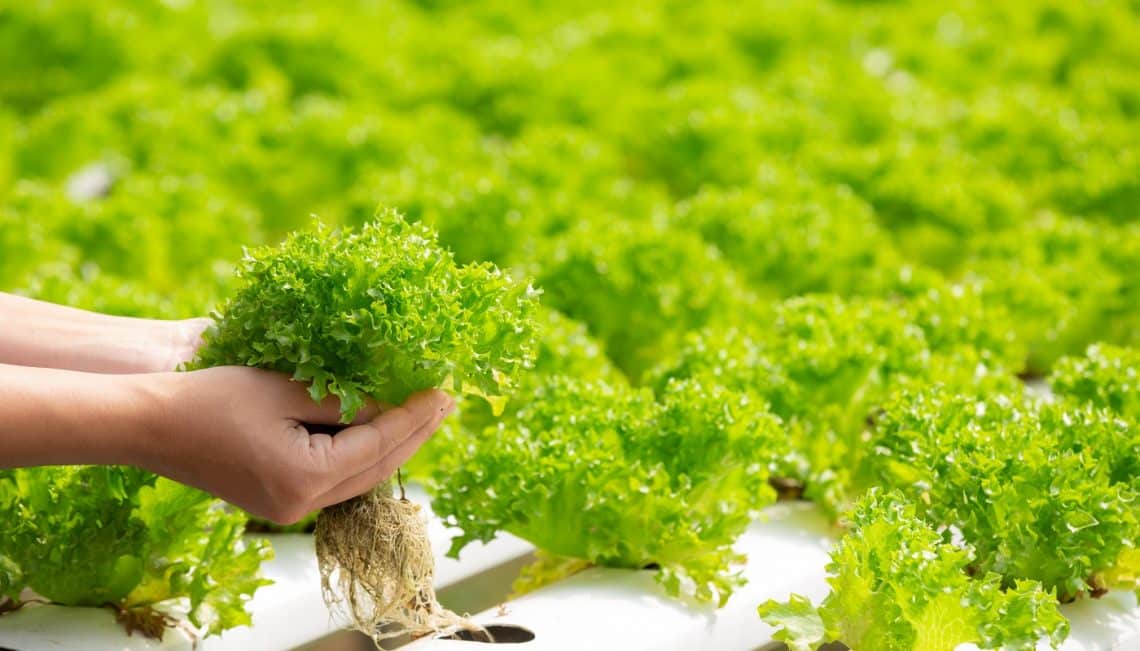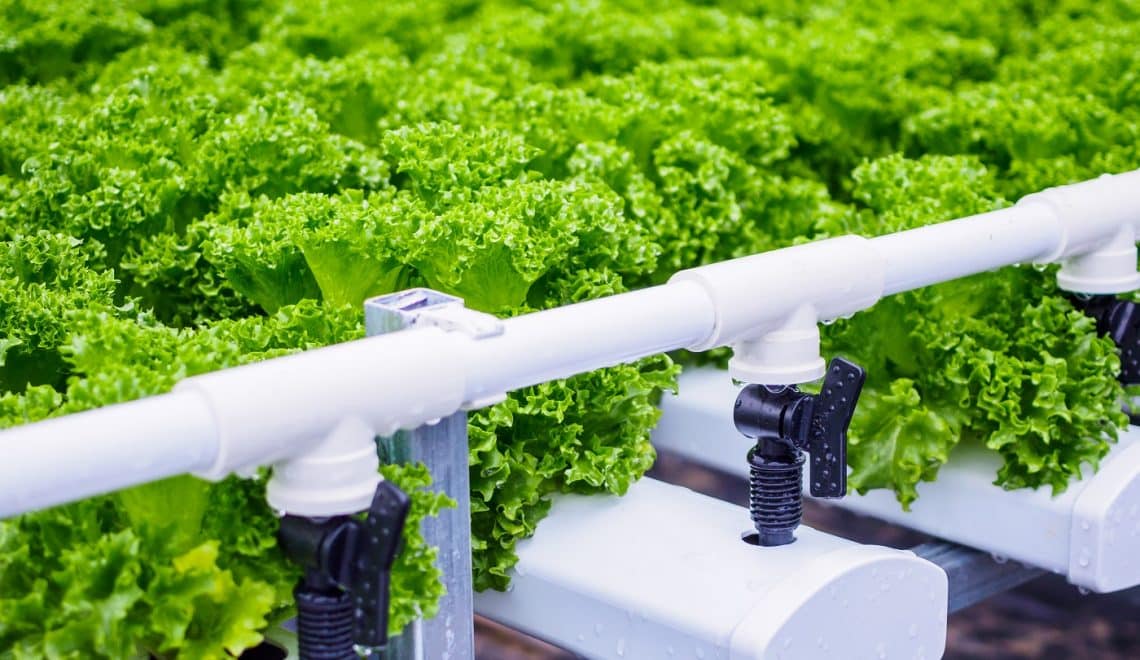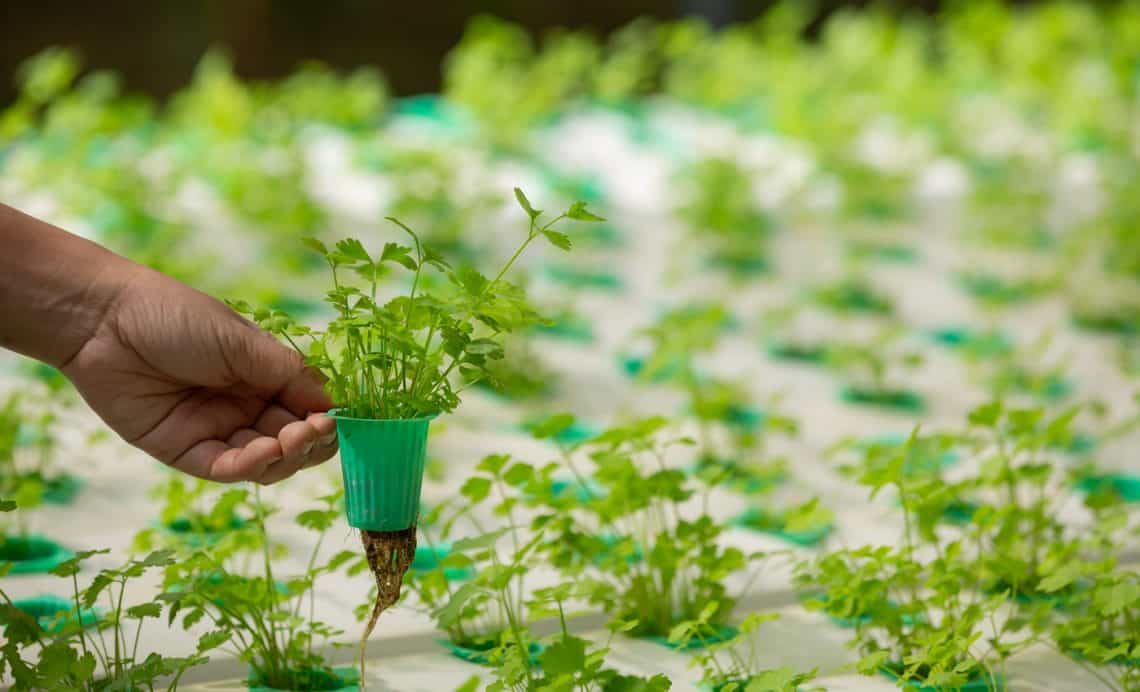In this modern-day and age, people are finding new ways of growing plants!
They are using hydroponic systems, especially the deep water culture system. Now, we know all this might sound a little confusing, but in reality, it is not.
There are several kinds of hydroponic systems out there, like the deep water culture, nutrient film technique, ebb, and flow. In this article, however, we are going to delve deep into knowing the nitty-gritty of the former.
- Easy to use inexpensive complete kit - Deep Water...
- Includes 5 Gallon HDPE Bucket + 6 inch Basket Lid
Deep water culture or DWC is not only the most sought-after system, but it is also the simplest one. So, without wasting any further time, let us get right into it.
![Deep Water Culture [Dwc] [Hydroponic System 101] 13 Fresh organic green leaves lettuce salad plant in hydroponics vegetables farm system](https://dev.architecturelab.net/wp-content/uploads/2021/05/Deep-Water-Culture-02-605x350.jpg)
What Does The Term ‘Deep Water Culture’ Mean?
In simple words, deep water culture is the process of growing plants without taking the help of any substrate media. The plant roots are wrapped in a net pot, and then they are hung from a lid with their roots hanging in nutrient-rich water.
The water is high in oxygen as it is pumped into the reservoir by an air pump; this helps the plants receive nutrients; hence, ensuring productive plant growth.
Throughout the process, the air pump plays a very crucial role. So, you must ensure that it is on all the time, or else the plant roots will stop receiving oxygen and start decaying. Once you have ensured that the plant has developed a strong root, you can lower the amount of water in the reservoir.
What Are The Main Parts Of Deep Water Culture?
So, as mentioned earlier, there are three main parts of this entire process.
-
Water
Consider water to be the soil in this process. And the bright side is that you won’t ever have to water your plant again.
-
Oxygen
Since the roots are submerged in water, it needs to have a proper amount of oxygen; otherwise, the plant will drown. This is made possible with the help of an air stone and air pump.
-
Nutrients
Since the plant is submerged in water and not in the soil, you need to supplement it with nutrients for it to grow.
Now, there are mainly two reasons why this process is called deep water culture. First, you grow the plant in a reservoir that holds a good amount of water. More water means more nutrients, which means you do not have to keep a check on its growth.
And the second reason is that your plant’s roots are always submerged in water, which is quite unlike the other methods, such as the ebb and flow systems.
![Deep Water Culture [Dwc] [Hydroponic System 101] 14 51hwjescnhl. Sl500](https://m.media-amazon.com/images/I/51hwJESCNhL._SL500_.jpg)
Perks Of Deep Water Culture
There are many perks/advantages of using the deep water culture system. For starters, it is one of the simplest forms of the hydroponic system; wicking is the only simpler system. Below are some of the perks it offers:
- Easy to assemble as it has very few moving parts
- Does not demand a high-maintenance cost once it has been set up.
- It has a faster-growing time when compared to soil
- Since the roots of the plants are submerged in water, it does not require fertilizers
Drawbacks Of Deep Water Culture
Deep water culture has its fair share of downsides as well. There are several issues with this system that might cause problems for you.
- Maintaining a consistent water temperature can be quite difficult
- You have to maintain a consistent electric supply; otherwise, the roots may drown as there will be low oxygen in the water.
- You have to take extra care of the water level, ph, and nutrient concentration as they are prone to fluctuations in small systems.
- In small systems, over calibration or under calibration is very easy because of the small scale.
Types Of Deep Water Culture
There are mainly four types of variations of this water culture system
-
The Traditional Method
The traditional method is the easiest to build. First, you need to connect the pump to the tubing and then ensure that the tubing is connected to the airstone. After this, you may place the airstone in the bucket.
Next, fill the bucket with water, add the nutrients, and then the seeds. Soon your plant will start germinating, and the roots will hit the water. And within no time you will be able to see your plant growing.
After all, they do not need to spend the extra energy to search for water in the soil. Instead, they can consume as much water as they need along with all the beneficial nutrients.
You just need to ensure it is properly oxygenated; this will make the root of the plant remain submerged in water for a very long period of time.
![Deep Water Culture [Dwc] [Hydroponic System 101] 15 512z0s0rmdl. Sl500](https://m.media-amazon.com/images/I/512Z0s0rmDL._SL500_.jpg)
Why Does The Traditional Method Work?
The traditional method works because the roots of the plants are submerged in highly oxygenated water containing all the beneficial nutrients. Plants that are grown in the traditional deep water culture system are expected to be harvested better and twice as fast as plants grown in normal soil.
Our team of experts had harvested a head of lettuce in almost 30 days from the time of its germination, whereas with soil, it took us more than 60 days.
How To Set Up A Deep Water Culture System?
You can set up a deep water culture system right from the comfort of your home. You will be needing:-
-
- Air pump
- Firestone
- Airline
- A reservoir
- pH kits
- pH meters
- Growing media like expanding clay or Rockwool
You can purchase these items from your nearby gardening supply store; these items are also available online. While purchasing a reservoir, you must ensure that you buy a light-colored one through which light can pass, affecting the root growth.
In the first step, you will need to fill up your reservoir with nutrient-enriched solution to the base of the net pot. Then, you need to keep a check on the ph levels. We would strongly advise you to keep it between 5.5 and 6.5.
After this, connect the airline to the airstone and the air pump to the airline. You are then required to place this in the reservoir along with your plant and growing media, such as expanding clay.
Now you can turn on the pump, and your deep water culture system is ready. However, we would recommend you remove your plants every three weeks to refresh the nutrient solution.
- Easy to use inexpensive complete kit - Deep Water...
- Includes 5 Gallon HDPE Bucket + 6 inch Basket Lid
-
Bubbleponics
Bubbleponics is yet another variation of deep water culture. It is slightly different from the traditional method. Despite it being too similar to the traditional methods, there are few advantages that Bubbleponics have that you need to know about.
So, in this process, you do not wait for the plant to germinate or the roots to reach the top of the water; you instead speed the process up by top feeding the nutrients to your plants but only for the first few weeks.
The only difference in Bubbleponics is that there is an extra deep line that runs out of the tank to the net pots in which your plants are sitting. This ensures that the process of germination and the seedling phase is sped up.
-
Recirculating DWC
The traditional method is best suited for beginners; however, if you want to level up the scale of your system, we suggest you try RDWC. It stands for Recirculating Deep Water Culture system. People implement this system when they are looking to upgrade their garden.
It sounds super silly to have 10 individual buckets, each requiring their own adjustment and calibration. What would make more sense is if you had one main reservoir which feeds all the nutrients covering all the 10 buckets. This will require the implementation of the RDWC system.
The RDWC system here is that the water is shuttled around with spray nozzles that help in oxygenating the water. The difference is that you have to oxygenate, calibrate and add extra water from a single central location which feeds out to the remaining of the bucket immediately.
The best part about this is the power grid, which you do not have to run with your own generator; instead, it is generated from centralized locations to your house.
![Deep Water Culture [Dwc] [Hydroponic System 101] 17 51hg8kubs+l. Sl500](https://m.media-amazon.com/images/I/51hg8kuBs+L._SL500_.jpg)
-
The Krafty Method
The Krafty method, too, is an important method of the deep water culture system. This method is very different from that of any of the methods mentioned above. Neither does the Krafty method require a pump, nor does it require electricity. It is basically a passive system of deep water culture.
We are pretty sure you must be wondering how do the plants get oxygen and nutrients then? The thing is, you are required to leave a gap between the surface of the nutrient solution and the roots.
As the plant starts growing, the water level starts declining as the plants keep absorbing the water. The gap ensures that the plant can respire. The Krafty method is best suitable for small plants.
What Kind Of Plants Grow In Deep Water Culture?
Plants that do not contain any flowers are the most suitable for growing in a deep water culture system. The most commonly grown plant is lettuce; apart from it, different herbs can also be grown.
The plants grow faster, but they are also a lot healthier compared to plants grown on soil. You can also grow fruits like squash, vegetables like tomatoes, pepper; however, they demand a little extra effort from your end.
Frequently Asked Questions (FAQ) On Deep Water Culture
Below are some of the frequently asked questions concerning deep water culture. Our team of experts has answered these questions after extensive research and first-hand experience.
-
What Should Be The Temperature Of The Reservoir?
We understand that a perfect temperature can be very hard to maintain. However, we would suggest you keep it within 68 degrees Fahrenheit or 20 degrees celsius. Kindly ensure the temperature does not get much higher, or else the oxygen level in the water will start dropping.
Furthermore, ensure that the water temperature is kept above 60 degrees Fahrenheit or 16 degrees celsius. If the temperature gets lower, the plants will think that there is a change in seasons, and they will use their energy towards flowering.
-
What Nutrients Should You Use In A Deep Water Culture System?
In order to understand the kind of nutrients you should use, you need to have good knowledge of these three terms.
-
- Meso-nutrients
Meso-nutrients are basically secondary macronutrients. They includes calcium, sulfur, and magnesium
-
- Micronutrients
Micronutrients include chloride, iron, copper, boron, zinc, etc. all these nutrients are essential for plants
-
- NPK Ratio
NPK stands for nitrogen (N), phosphorus (P), and potassium(K), respectively. All these are essential macronutrients that are required for a plant’s optimum growth. You are going to find the NPK ratio on hydroponic nutrient solution bottles
We would suggest you create your own nutrient solution for your plant.
- Easy to use inexpensive complete kit - Deep Water...
- Includes 5 Gallon HDPE Bucket + 6 inch Basket Lid
-
When Is The Right Time To Have Nutrient Solutions Changed?
You should change your nutrient solution every three weeks. You also need to consider several factors like
-
- The kind of plant you are growing
- How big the reservoir is
- The stage of growth of the plant
If you do not want the hassle of changing the whole setup, you can at least add some nutrient solution water to maintain the optimum balance of nutrients. However, we suggest you keep changing the whole setup every three weeks.
![Deep Water Culture [Dwc] [Hydroponic System 101] 19 41hlvf ekrl. Sl500](https://m.media-amazon.com/images/I/41hLVf-EKrL._SL500_.jpg)
-
How Much Of The Plant Should Be Submerged In The DWC Reservoir?
Only the root of your plant needs to be submerged in the water. Ensure there is neither stem nor vegetation involved. You do not need to submerge the whole part of the root. We would strongly recommend you keep about 1.5″ of the root above the water.
The air stone will ensure that the bubbles reach the part of the root that is not submerged. You need not worry about the roots drying out.
-
How To Keep A Check On The Oxygen Level In The Nutrient Solution?
There are a ton of dissolved oxygen meters out there on the market. But we would not recommend you to waste your money on it as they are quite expensive and require precision.
In our opinion, the best way of keeping a check on the oxygen level is to merely do the required things that ensure the optimum level of oxygen. These include keeping the right temperature of the solution and keeping the air pump on.
-
What Kind Of System Should You Use, Singular Or Modular?
If you are new to deep water culture, we would suggest you go with a single reservoir system. A modular DWC system is specifically for those who know are aware of what they want to grow and how much they want to grow.
It is always better to start small and later scale up as you keep getting good at it with more experience.
-
What Are Some Of The Problems Concerning Deep Water Culture That People Should Watch Out For?
These are some of the problems which are common in almost all DWC systems. You must always keep a note of these:-
-
- Check if the temperature of the nutrient solution has become too hot
- Check out for plant’s root related diseases like pythium
- Check out for random fluctuations in pH
-
What Is The Rate Of Growth For Plants In The DWC System?
If you are doing everything right, the plants grown in a deep water culture system are expected to grow nearly 15% faster than plants that are grown on soil.
We have tested the entire process out and noticed that our lettuce grew almost twice as fast in the deep water culture system compared to the lettuce we tried growing in soil.
-
What Should Be The Optimum pH and PPM/EC For A Deep Water Culture System?
There’s no need to change the pH and PPM/EC just because you are growing a plant in a deep water culture system. Most plants prefer the standard range, from pH 5.5 – 6.5. Keep in mind though; you will be required to customize this based on the stage of growth the plant is in.
If it is vegetating, you would want to keep the pH on the higher side and if they are flowering, keep the pH on the lower side.
When it comes to PPM/EC, we would strongly advise you not to follow the feeding schedule provided at the back of the hydroponic nutrients. They are mostly higher than necessary.
You can try dividing the amount in half and see how your plant responds to it. You are always free to adjust upwards; however, adjusting downwards can be a little tricky as your plant has already gone through the nutrient burn.
- Easy to use inexpensive complete kit - Deep Water...
- Includes 5 Gallon HDPE Bucket + 6 inch Basket Lid
-
What Are Some Of The Best Tricks For Deep Water Culture Growing?
Yes, of course, there are quite a few tricks for deep water culture growing. As a deep water culture grower, you can easily control the rate of moisture in the roots; it can be beneficial for trigger plant reactions, such as fruiting, flowering, and essential oil production.
The more dry the root is, the more effective it is for oil production in scented crops, such as mint and basil.
On the other hand, a wet root can force the plant to prioritize vegetative production, like large fan leaves, which help speed-up transpiration and photosynthesis.
![Deep Water Culture [Dwc] [Hydroponic System 101] 21 Hydroponics system, planting vegetables and herbs without using soil for health, modern food and agricultural design concepts.](https://dev.architecturelab.net/wp-content/uploads/2021/05/Deep-Water-Culture-03-576x350.jpg)
Final Words
There you have it; above was pretty much everything you needed to know about deep water culture. Most growers view the system as the purest form of hydroponics.
So, if you are starting new, you should go for it as it is one of the cheapest and most accessible types of hydroponic systems. And if everything is done correctly, your plants are bound to thrive.
We hope you have gained some valuable information on deep water culture from this article. Till next time!
Related Articles
Clay Pebbles in Hydroponic System 101 [Tips & Growing Guide]
5 Best Hydroponic System for Tomatoes
Coconut Coir [What Is Coco Coir & How To Use It In Hydroponics]
How To Sell Microgreens 101 [Guide & Tips]
9 Best Garden Tower Planters for Enthusiasts
Hydroponic Wick System Garden 101 [Guide & Tips]
How Fast Do Succulents Grow [How to Grow Succulents Faster]
8 Best Hydroponic Drip System [Reviewed & Buyer’s Guide]
What is Rockwool & Rockwool Cubes [Using Rockwool in Hydroponics]
What is Perlite, Vermiculite [Differences, Guide & How to Use Them]






![Deep Water Culture [Dwc] [Hydroponic System 101] 1 Hydroponics system, planting vegetables and herbs without using soil for health, modern food and agricultural design concepts.](https://dev.architecturelab.net/wp-content/uploads/2021/05/Deep-Water-Culture-01.jpg)
![Deep Water Culture [Dwc] [Hydroponic System 101] 12 Deep water culture (dwc) hydroponic bucket kit 5 gallon, 6 inch](https://m.media-amazon.com/images/I/51jNlPXbF2L.jpg)